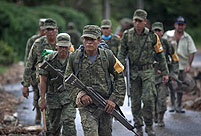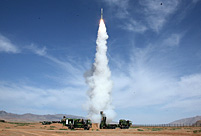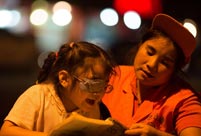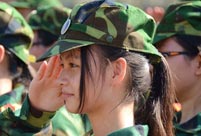The secret gravestone
"The search for surviving KMT veterans of World War II once led me to a man in an impoverished village in Guizhou province in southwest China. Rumors had been circulating among the locals that the old man, who had been tortured both physically and mentally during the "cultural revolution" (1966-76), had long had his own tombstone carved and buried underground," Sun recalled.
After spending several nights talking to the man, Sun and his fellow volunteers finally persuaded the 89-year-old to dig the tombstone out from where it had been hidden in the mountain.
The roughly hewn slab bore four hand-carved Chinese characters: Er Zhan Lao Bing, which means Veteran of WWII.
"I don't know how long it lasted, but we just stood there and let the tears flow," Sun said. "That man deserves a monument."
It is the same heartache, compounded by an enormous sense of guilt at being able to offer so little consolation to the men Sun calls "our national heroes" that motivates him and his fellow volunteers. Their number has grown from fewer than 100 to 2,000 during the past 10 years. Like Mei's father, many of them joined after being made aware of the wartime history of their own senior family members.
The announcement from the Civil Affairs Ministry gives them reason to hope for more. However, according to Fan Jianchuan, an amateur researcher into China's World War II history, it will take time for the changes, which didn't happen overnight, to have a real impact.
"The end of the 'cultural revolution' effectively put a stop to the harsh treatment of former KMT soldiers. And the country's reform and opening-up policy in the 1980s added yeast to this perpetually fermenting society, stimulating debate in all areas," he said.
"The turning point came in 2005, which marked the 60th anniversary of the end of World War II. In a landmark speech, the then Chinese president Hu Jintao paid a fulsome tribute to 'the frontline of the battlefield', where the KMT army collided with the Japanese, at huge human cost.
"On that occasion, the government had special commemorative medals minted and issued to the veterans, including KMT generals who were still living on the mainland, but not to the ordinary KMT soldiers," Fan said.
A self-proclaimed collecting enthusiast who funds his hobby through his real estate business, Fan eventually built a number of war museums in his native Sichuan province, where the Kuomintang government drafted 3.2 million young men, including his father, during the eight-year War of Resistance against Japanese Aggression. Nearly one-third of those men never returned home.
"I grew up having learned not to talk about it," 56-year-old Fan said. "But like a faint, yet persistent whisper, it has affected my life and the lives of those around me."
Since they were opened in 2005, the museums, including one dedicated solely to the Kuomintang's side of the story, have had more than 200,000 visitors a year, including leading members of the Chinese Communist Party and the KMT in Taiwan.


 Storms leave 97 dead, 58 missing in Mexico
Storms leave 97 dead, 58 missing in Mexico New model of indigenous surface-to-air missiles testfired
New model of indigenous surface-to-air missiles testfired  118.28-carat diamond to be auctioned in HK
118.28-carat diamond to be auctioned in HK Maternal love under streetlight
Maternal love under streetlight Naked foreign student sits in the middle of a road in Haikou
Naked foreign student sits in the middle of a road in Haikou  Colorful Yunnan: Enjoy the natural beauty
Colorful Yunnan: Enjoy the natural beauty Harbin named Chinese city with most beautiful women
Harbin named Chinese city with most beautiful women New college students' military training in Guangzhou
New college students' military training in Guangzhou Rugby girls
Rugby girls PLA's 38th Group Army conduct training
PLA's 38th Group Army conduct training Residences of the royal house of Savoy
Residences of the royal house of Savoy The last days of Wan Aihua
The last days of Wan Aihua Highlights at 12th National Games of China
Highlights at 12th National Games of China Beijing Film Academy welcomes freshmen
Beijing Film Academy welcomes freshmen Large mahjong party sets new world record
Large mahjong party sets new world recordDay|Week|Month